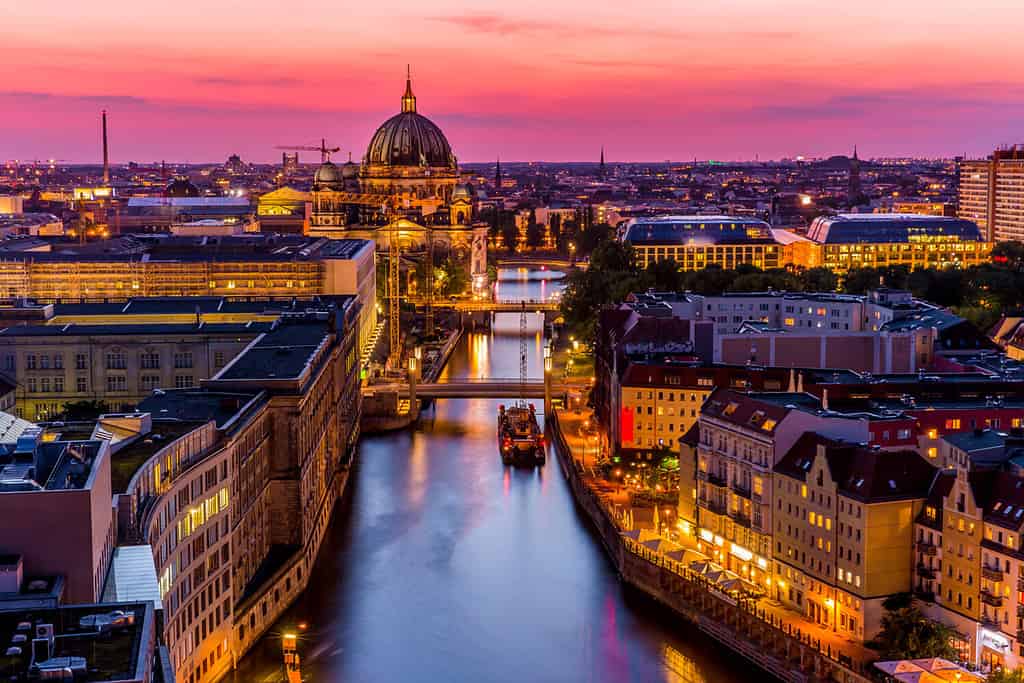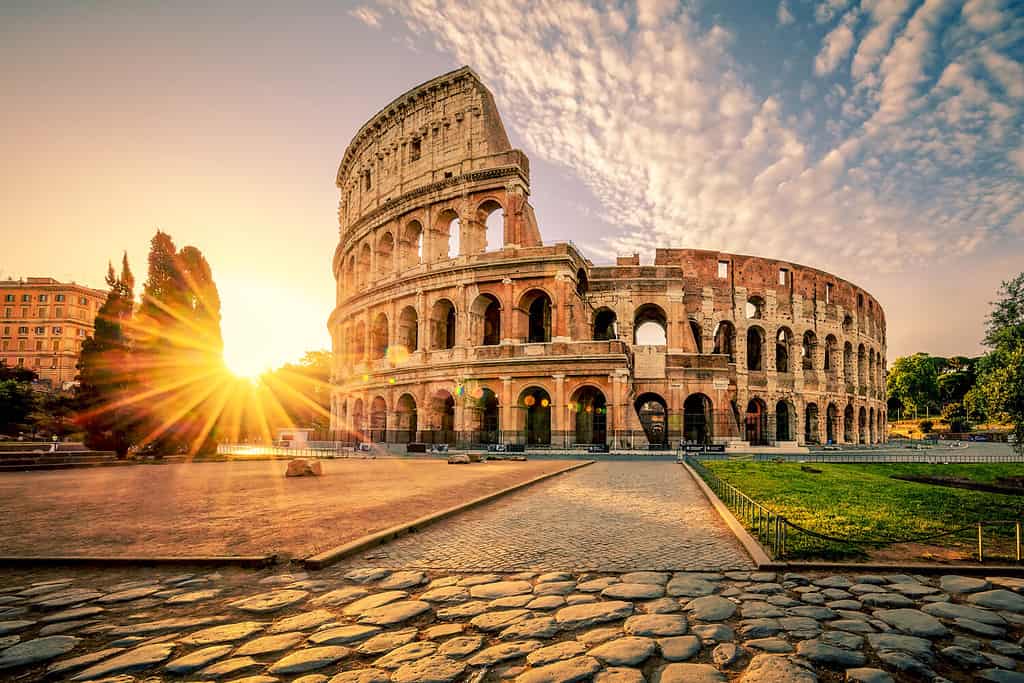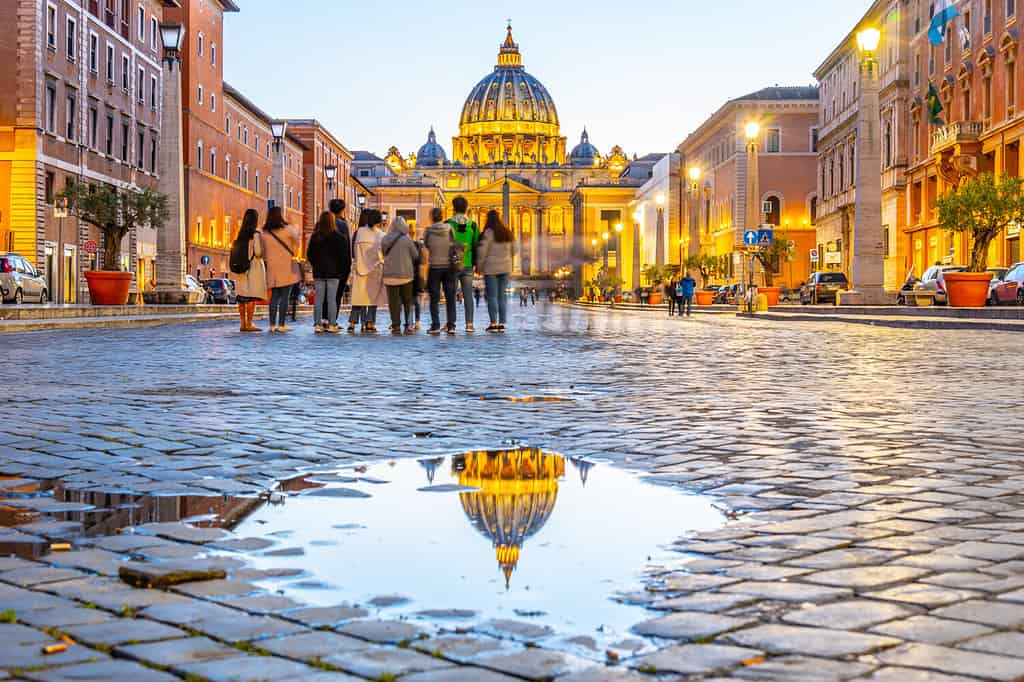Unlike the days of the week, not all countries end in Y, but the ones that do are really neat! Out of all the countries on our list, five are in Europe, two are in South America, and one is in both Europe and Asia.
Of the 195 countries in the world, only 8 of their names end in the letter Y. Keep reading to learn about these unique places!
Germany

Berlin is the capital city of Germany, and it’s home to a lot of the country’s citizens.
©Finn stock/Shutterstock.com
The first country on our list by alphabetical order is Germany, which is officially called the Federal Republic of Germany. The capital of Germany is Berlin, and the country’s population is 85,887,000. It takes up about 138,100 square miles of total area, making it the 63rd-largest country in the world!
Germany is a federal republic like the United States and it’s made of 16 states that have their own laws and responsibilities. Within the country, there are different landscapes. The Danube, Main, and Rhine river valleys cut through the central and southern mountainous regions of Germany. The northern region of Germany is flatter and its border is adjacent to the North Sea.
Germany is full of animals and wildlife, which the government works hard to protect with its 97 nature reserves. Within the southern region, you’ll find animals like wildcats, ibex, and boar. In the northern reserves, you can observe species of whales off the coast, and small animals like beavers and minks.
Hungary

The Hungarian Parliament building in Budapest is a particularly striking work of architecture.
©R.M. Nunes/iStock via Getty Images
Compared to Germany, Hungary is a much smaller country, coming in at 35,918 square miles of total area. It’s also a part of Europe, but it’s landlocked, so it has no coastline. The capital of Hungary is Budapest, and the population of the country is approximately 9,678,000.
Hungary is a parliamentary republic with universal health care and tuition-free secondary education. After the country was defeated in World War I, it lost two-thirds of its population and territory. This loss resulted in something called “Trianon Syndrome” in which half the country was still concerned about losing territory and people, while the other half was trying to forget it and move on. Modern Hungary is still locked in a battle between these two ways of thought, and it shows in its culture, social activities, and politics.
The land of Hungary is mainly flat, with a large area called the Great Hungarian Plain that is used for agriculture. The Danube River (which also passes through Germany) runs through the middle of Hungary and onto the Black Sea. It’s the largest river in the country and the only river in the world to pass through 10 nations.
Italy

Italy has a rich history that makes the country a popular tourist destination.
©prochasson frederic/Shutterstock.com
Just smaller than Germany by total area is Italy, at 116,348 square miles. The boot-shaped peninsula in Europe has a population of 62,246,674 and plenty of history to show off.
Italy has long been the center of culture and art for the world. Some of the most well-known artists come from the country, including Michelangelo and Leonardo da Vinci. It’s one of the top tourist destinations for art, architecture, and history.
Besides the man-made parts of Italy, the country boasts gorgeous nature and ancient ruins. The country isn’t covered in as many forests as it was in the past, but there are national parks and other wild areas. There are many types of animals that live in Italy including the country’s national animal — the Italian wolf. It’s home to the smallest known mammals, Etruscan shrews, each of which weigh just slightly more than a paperclip.
Norway

Jostedalsbreen National Park is just one of the many nature preserves worth visiting in Norway.
©iStock.com/Travel Faery
The Kingdom of Norway, or Norway, is a country in northern Europe on the Scandinavian Peninsula. It has a total area of 148,726 square miles, making it just larger than Germany. It’s the 7th-largest country in Europe and the 61st-largest in the world. Despite being a fairly large country, Norway has a pretty small population of 5,372,191.
Norway is a constitutional monarchy, so it is ruled by a king and a parliament which the Norweigan citizens elect. The country is divided into 19 counties, each ruled by a governor that the king selects.
Something that makes Norway extra special is its wildlife. Norway feels like a land out of a fairytale — with over 2,000 species of plants, thick evergreen forests, and wild berries that grow abundantly. Reindeer, elk, and red deer roam the inland forests and nesting birds like puffins make their homes in the sea cliffs.
Paraguay

The Presidential Palace in Paraguay is in the country’s capital city of Asunción.
©Don Mammoser/Shutterstock.com
The Republic of Paraguay is the first country on our list so far outside of Europe. It’s a landlocked country in the center of South America. It takes up 157,048 square miles, making it just a bit larger than Norway. Paraguay has a population of 6,109,644, but nearly one-third of the citizens live in the capital city of Asunción.
Paraguay is a representative democratic republic which means it has a president and a separation of powers across the executive, legislative, and judicial branches. There is compulsory military service for its citizens, so every male over 18 must serve a year of active duty.
Rivers cut through almost all of Paraguay and serve many purposes, like giving the landlocked country access to the Atlantic Ocean. The rivers also contribute to Paraguay’s success as a leading exporter of hydroelectric power.
Turkey

Istanbul is the largest city in Turkey.
©Resul Muslu/Shutterstock.com
The Republic of Turkey is a large country that connects Europe with Asia. It bridges the two countries so part of Turkey is in Europe and the other part (the majority) is in Asia. It has a total area of 302,535 square miles, making it the largest country on our list and the 36th-largest in the world. Turkey has a population of 81,257,239, and while Ankara is the capital, the largest city is Istanbul.
Turkey is a parliamentary democracy — the prime minister is in charge of the country along with the 600-member Grand National Assembly. Members of the Assembly are chosen by the people and serve five-year terms. The Assembly elects a president, who shares the role of head of state with the prime minister.
Turkey has 39 national parks, several of which provide resting locations for migrating birds. Aside from the national parks, a lot of Turkey’s land has been used for agriculture. Deforestation and animal grazing have altered the country so it looks different than it did before. The destruction of natural habitat has led to a decline in multiple animal species.
Uruguay

Aside from Montevideo, most of Uruguay is made up of farmland.
©Leonid Andronov/iStock via Getty Images
The Oriental Republic of Uruguay is the 2nd-smallest country in South America at 181,034 square miles total area. It’s home to around 3,500,000 citizens, and the majority of its citizens live in the capital city of Montevideo. About a third of the country borders water, with most of the coastline lying along the Atlantic Ocean.
Uruguay is a constitutional republic with a president and vice president that citizens are required to vote on. The main industry is agriculture with the majority of the land focused on livestock production. Another large industry in Uruguay is tourism.
Since so much of Uruguay is dedicated to agriculture, most of the native wildlife has disappeared. There are a few national parks and reserves where the country has worked to protect the land and animals that are left.
Vatican City

Vatican City is unique because The Pope holds complete power over the government in the country.
©Pyty/Shutterstock.com
The State of Vatican City is the smallest country in the world by area and population with just 0.19 square miles of land and no water territory. Despite being four times smaller than Disneyland, the country has 764 citizens. Vatican City was a part of Italy for a long time but it became independent in 1929 with the Lateran Treaty.
The country operates as an absolute elective monarchy, which gives full power to the head of the Catholic Church. The Pope holds complete legislative, executive, and judicial power over Vatican City, making it the only absolute monarchy in Europe.
The photo featured at the top of this post is © Travel Turkey/Shutterstock.com
Thank you for reading! Have some feedback for us? Contact the AZ Animals editorial team.






